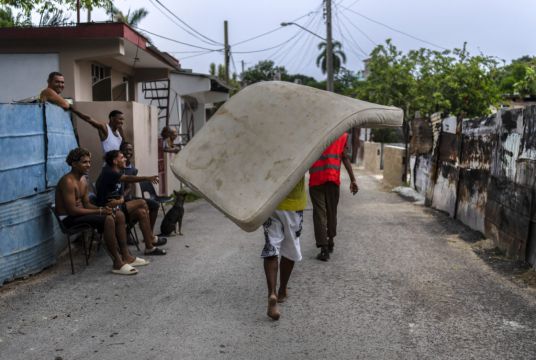A strengthening Hurricane Ian is lashing Cuba’s western tip, where authorities have evacuated 50,000 people, after it became a major Category 3 storm on a path that could see it hit Florida’s west coast at Category 4.
The storm made landfall early on Tuesday in Cuba’s Pinar del Rio province, where officials set up 55 shelters, rushed in emergency personnel and took steps to protect crops in Cuba’s main tobacco-growing region.
The US National Hurricane Centre said the island’s west coast could see as much as 14ft of storm surge.
Here are the 5 AM EDT Key Messages for Major Hurricane #Ian. More: https://t.co/tW4KeFW0gB pic.twitter.com/0uzMONna9h
— National Hurricane Center (@NHC_Atlantic) September 27, 2022
Advertisement
“Cuba is expecting extreme hurricane-force winds, also life-threatening storm surge and heavy rainfall,” hurricane centre senior specialist Daniel Brown told the Associated Press.
After passing over Cuba, Ian is forecast to strengthen further over warm Gulf of Mexico waters before reaching Florida as early as Wednesday as a Category 4 storm with top winds of 140mph.
Tampa and St Petersburg appeared to be the among the most likely targets for their first direct hit by a major hurricane since 1921.
“Please treat this storm seriously. It’s the real deal. This is not a drill,” Hillsborough County emergency management director Timothy Dudley said at a news conference on storm preparations in Tampa.

In Havana on Monday, fishermen took their boats out of the water along the famous Malecon seaside boulevard, and city workers were unclogging storm drains ahead of the expected rain.
The hurricane centre said in an update at 4.30am local time that Ian made landfall in Cuba as it continued to strengthen, with sustained winds of 125mph. The centre defines a major hurricane as Category 3 or higher, meaning maximum sustained winds of at least 111mph, and Ian became a Category 3 hurricane earlier on Tuesday.
The centre said “significant wind and storm surge impacts” are expected on Tuesday morning in western Cuba.
Ian will not linger over Cuba but will slow down over the Gulf of Mexico, growing wider and stronger, “which will have the potential to produce significant wind and storm surge impacts along the west coast of Florida”, the hurricane centre said.
A surge of up to 10ft of ocean water and 10in of rain was predicted across the Tampa Bay area, with as much as 15in in isolated areas. That is enough water to inundate coastal communities.
As many as 300,000 people may be evacuated from low-lying areas in Hillsborough County alone, county administrator Bonnie Wise said, with schools and other locations opening as shelters.
School districts in 24 counties have announced school closures, and we expect more as #Ian approaches and the track becomes more certain.
Visit https://t.co/0WxInGqbY5 for the latest updates.— Ron DeSantis (@GovRonDeSantis) September 26, 2022
Florida governor Ron DeSantis declared a state-wide emergency and warned that Ian could lash large areas of the state, knocking out power and interrupting fuel supplies as it swirls northwards off the state’s Gulf Coast.
“You have a significant storm that may end up being a Category 4 hurricane,” he said at a news conference. “That’s going to cause a huge amount of storm surge. You’re going to have flood events. You’re going to have a lot of different impacts.”
He said the state has suspended tolls around the Tampa Bay area and mobilised 5,000 Florida state national guard troops, with another 2,000 on standby in neighbouring states.
President Joe Biden also declared an emergency, authorising the Department of Homeland Security and the Federal Emergency Management Agency to co-ordinate disaster relief and provide assistance to protect lives and property. The president postponed a scheduled Tuesday trip to Florida because of the storm.







